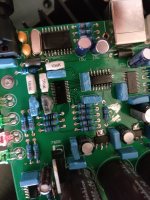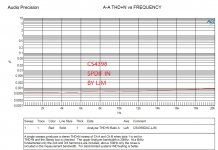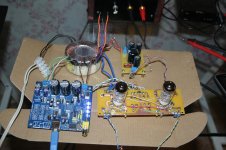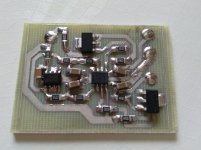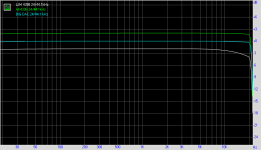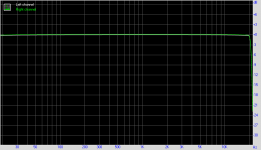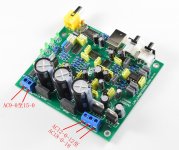Thanks for your input.
After resoldering as you suggested, the locked LED is working again with optical and USB.
But now I don't get sound out of it
Found out that the 7812 regulator is getting hot too much. After measuring the voltages I found out that its not putting out 12 V but only 1V
After exchanging it is still only 1 V.
I have a second PCB because I ordered two, maybe next week I start over again...
220uF cap behind 7812 is the only filter cap that should be oriented differently from all others at the input, maybe you made the same mistake as me and switched polarity
For me, now the biggest problem is that overall, this DAC simply does not sound too good. I have old chinese diyeden DAC that is noticably better, and we are talking about 100eur range.
Hi, my first post on this great forum, i hope useful ...
I bought DAC, and made attempt to restore scheme.
Bought from this seller:
CS8416 CS4398 DAC Kit Support USB Transformer Support USB and Coaxial Input SN | eBay
Comments are welcome ...
Remove the capacitor 1nF of the output stage can cause instability? or are for filter?
Hi.
Is there a great guy who knows the value of L1 and L2 inductors for cs4398 cm102s usb dac.
Best regards
It's not really coil , it's wire that passes inside ferrite tube....
WBR, Alex
I just ordered one of these kits with usb and optical inputs.
Looking at pictures of the board, I see no switch or headers to switch between the inputs. Does it automatically lock onto the one with signal present?
Input switch is not needed, recognition signal is automatic ...
WBR, Alex
Never mind, got frustrated and blasted the board with a hot air gun to reflow all pins on the ICs at the same time. It works fine now, but I fried a lot of caps. 
I don't want to replace all those caps, so I ordered a new kit where I will reflow all ICs properly before I populate the board.
I can use my current board for experiments.
I don't want to replace all those caps, so I ordered a new kit where I will reflow all ICs properly before I populate the board.
I can use my current board for experiments.
Attachments
Last edited:
I have a problem with input selection.
when testing with a laptop and an spdif source the usb signal unlocked fine a while after I stopped playing music on the computer. When I connect it to my desktop computer, the dacs locks on USB as long as the cable is plugged in.
Any suggestions how I can get usb to unlock when there's no sound?
when testing with a laptop and an spdif source the usb signal unlocked fine a while after I stopped playing music on the computer. When I connect it to my desktop computer, the dacs locks on USB as long as the cable is plugged in.
Any suggestions how I can get usb to unlock when there's no sound?
As title says I did buy this eBay DAC board and associated enclosure from along1986090. Used my transformers.
CS4398 with CS8416+CM102s, provides coaxial SPDIF and USB inputs.
First impressions:
Enclosure definitelly well done, with (almost) all necessary hardware, holes in exact locations to match the board. Kind of long (10", plus 1/4" front aluminium plate), I guess it can be used to add a dedicated headphones amp.
I did buy the pre-solderd board. Inspected with the magnifier glass showed an OK grade of soldering. PCB is in filled ground technique and parts are like shown in the picture.
Initial tests had a sligtly distorted signal and analized with my E-MU1820m showed a really bad signal. I did replace the 5532 that was on board with LM4562 that I hade around and everything started to look better. I suspect that the 5532 was either a fake or a damaged exemplar. There is no capacitor or resitors on OpAmp outputs, so it is easy to be damaged.
At -2dB looks decent. The output stage overloads my ADC input at higher than -2dB (all the other DAC's that I tested didn't manage to do that).
The output stage is not done per recomended schematics in the datasheet.
USB input:
CM102 locks only onto 16bit/48kHz signals. 16bit/44.1kHz is not supported in Windows7 mixer (WASAPI).
If looses the connection with the PC, static noise is outputted till the next power off/on cycle. The automatic switching could be done better I guess...
Altough in Win 7 there is no need for drivers, here is a package that provides a little more that basic USB. This driver looks like it does the resampling to 48kHz automatically.
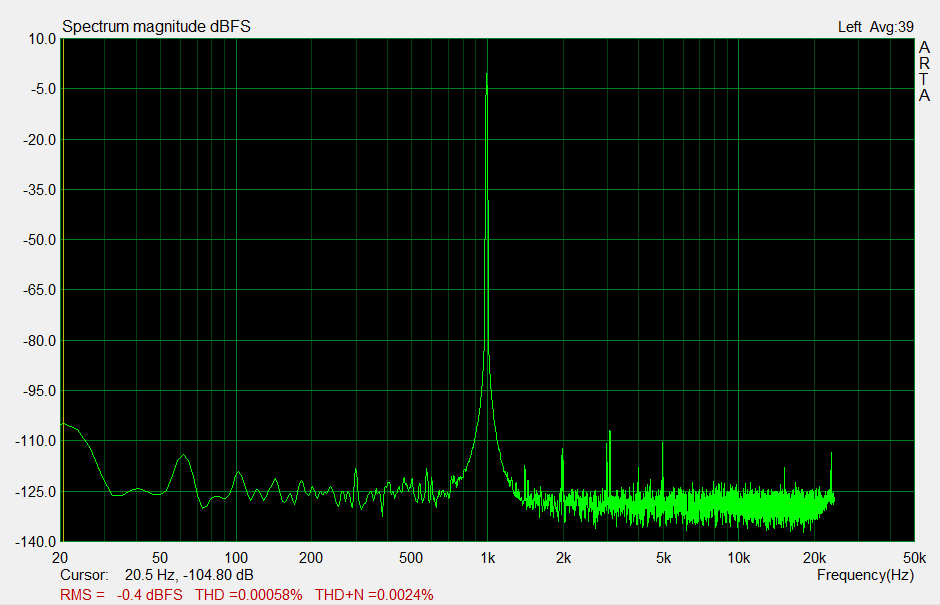
Coax SPDIF:
Locks on 44.1-96kHz, 16 or 24 bit. I don't have a SPDIF source capable of 192kHz to fully test the CS8416.
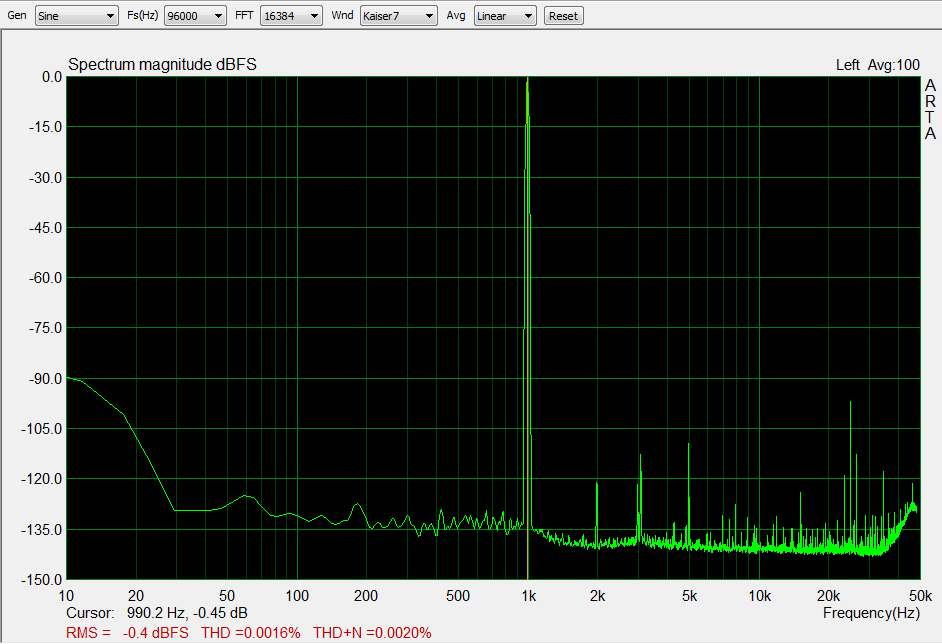
Using Foobar with resampling to 48kHz would allow USB connection to work at any rate, but I do prefer the coax.
All in all, sounds decent, especially for the price. THD+N with LM4562 is at -94dB. OpAmp upgrade is strongly recomended and looks like some of the AC grid noise could be reduced by better filtering.
Direct coupling of the outputs leaves some higher levels of 10Hz noise creep into the output chain as seen in the coax graph (at USB I forgot to extend the range below 20Hz).
The seller give the schematics (at my request).
5532 is very good. And very cheap. Manufacturers will not produce fake.
NE5532 is an open internal circuit, there are many manufacturers in the production. So it was very cheap.
It doesn't mean it's bad performance.
Believe I'm NE5532 home furnishings. And it will not damage.
At least I sell out of the number of more than ten thousand. Have not heard about the possibility of damage.
And I don't think the LM 4562 any performance.
And I don't recommend to do any changes. Of course. 222 the capacitance can be reduced
Such as the use of 102 n = 1. It can reduce high frequency attenuation.
All the other. Don't need to change. Because there won't be affected.
Attachments
Never mind, got frustrated and blasted the board with a hot air gun to reflow all pins on the ICs at the same time. It works fine now, but I fried a lot of caps.
I don't want to replace all those caps, so I ordered a new kit where I will reflow all ICs properly before I populate the board.
I can use my current board for experiments.
This looks horrible. Like sulfuric acid.
The test of IC is through artificial optical. There will be no problem. Don't want to get them down.
Install only need to use the constant temperature soldering iron. Can not use 220 v - 110 - v soldering pen is ok.
My experience
Hi Guys,
I used this board in my setup. Instead of OpAmp I used tube output.
It played really good through CM6631A USB receiver, but...
When I applied a small tweak to VREF and VA it started to play really better. I added RC after 5V AMS (10 Ohm + Low ESR 3300uF shunted with stock PP). These power supply lines are quite sensitive. Also I put VD to the digital 9V PS line instead of audio.
The next step is to add Voltage Ref + LPF + OpAmp + transistor separately for VA and VREF. It is cheap but gives tremendous change in sound. I used this tweak with AK4490EQ DAC and the difference is huge.
BTW, after a year of permanent usage I tried to use stock USB input and it did not work. But I do not care, CM6631A does excellent re-clock and supports up to 192/24.
Hi Guys,
I used this board in my setup. Instead of OpAmp I used tube output.
It played really good through CM6631A USB receiver, but...
When I applied a small tweak to VREF and VA it started to play really better. I added RC after 5V AMS (10 Ohm + Low ESR 3300uF shunted with stock PP). These power supply lines are quite sensitive. Also I put VD to the digital 9V PS line instead of audio.
The next step is to add Voltage Ref + LPF + OpAmp + transistor separately for VA and VREF. It is cheap but gives tremendous change in sound. I used this tweak with AK4490EQ DAC and the difference is huge.
BTW, after a year of permanent usage I tried to use stock USB input and it did not work. But I do not care, CM6631A does excellent re-clock and supports up to 192/24.
Attachments
Last edited:
Can't get a flat response
I just can't seem to get a flat response out of my dac.
It begins rolling rolling off at about 10kHz being .32dB down (@ 10k) and by the time it's got to 20kHz it's about 1.89dB down.
My other DACs manage a fairly flat response right up to 20kHz.
I have experimented with different filter settings, however it looks as though the response is rolled off before even getting to the output filter.
Interestingly, the other CS4398 DAC I have has a much flatter response.
It's marginally better at 192kHz but not as good as it should be...
Note: All measurements shown performed at 24/44.1kHz
See graphs for reference - the second graph is my USB interface (Focusrite) at 24/44.1kHz
I just can't seem to get a flat response out of my dac.
It begins rolling rolling off at about 10kHz being .32dB down (@ 10k) and by the time it's got to 20kHz it's about 1.89dB down.
My other DACs manage a fairly flat response right up to 20kHz.
I have experimented with different filter settings, however it looks as though the response is rolled off before even getting to the output filter.
Interestingly, the other CS4398 DAC I have has a much flatter response.
It's marginally better at 192kHz but not as good as it should be...
Note: All measurements shown performed at 24/44.1kHz
See graphs for reference - the second graph is my USB interface (Focusrite) at 24/44.1kHz
Attachments
- Home
- Source & Line
- Digital Line Level
- DAC: CS4398 with CS8416+CM102s

